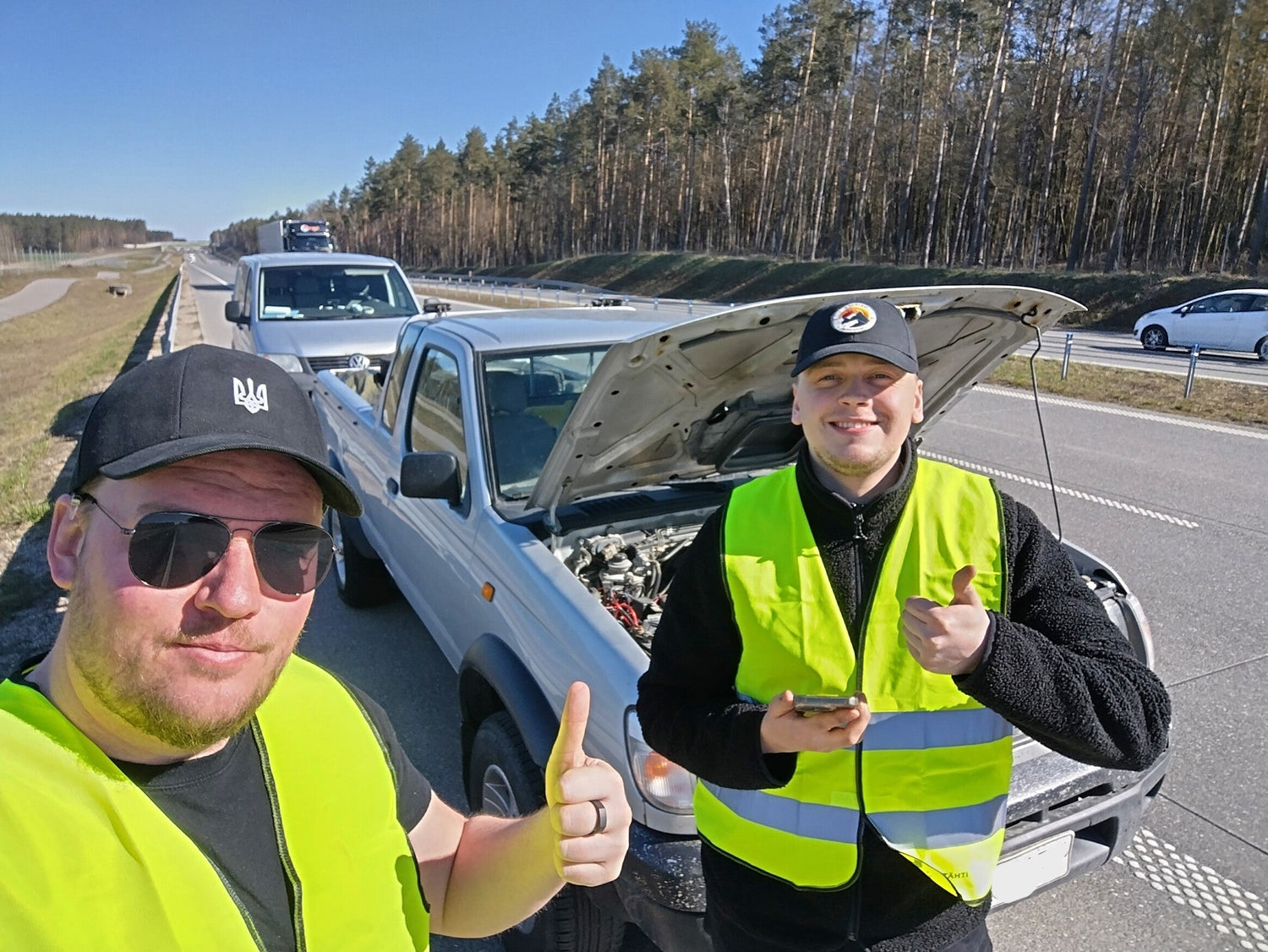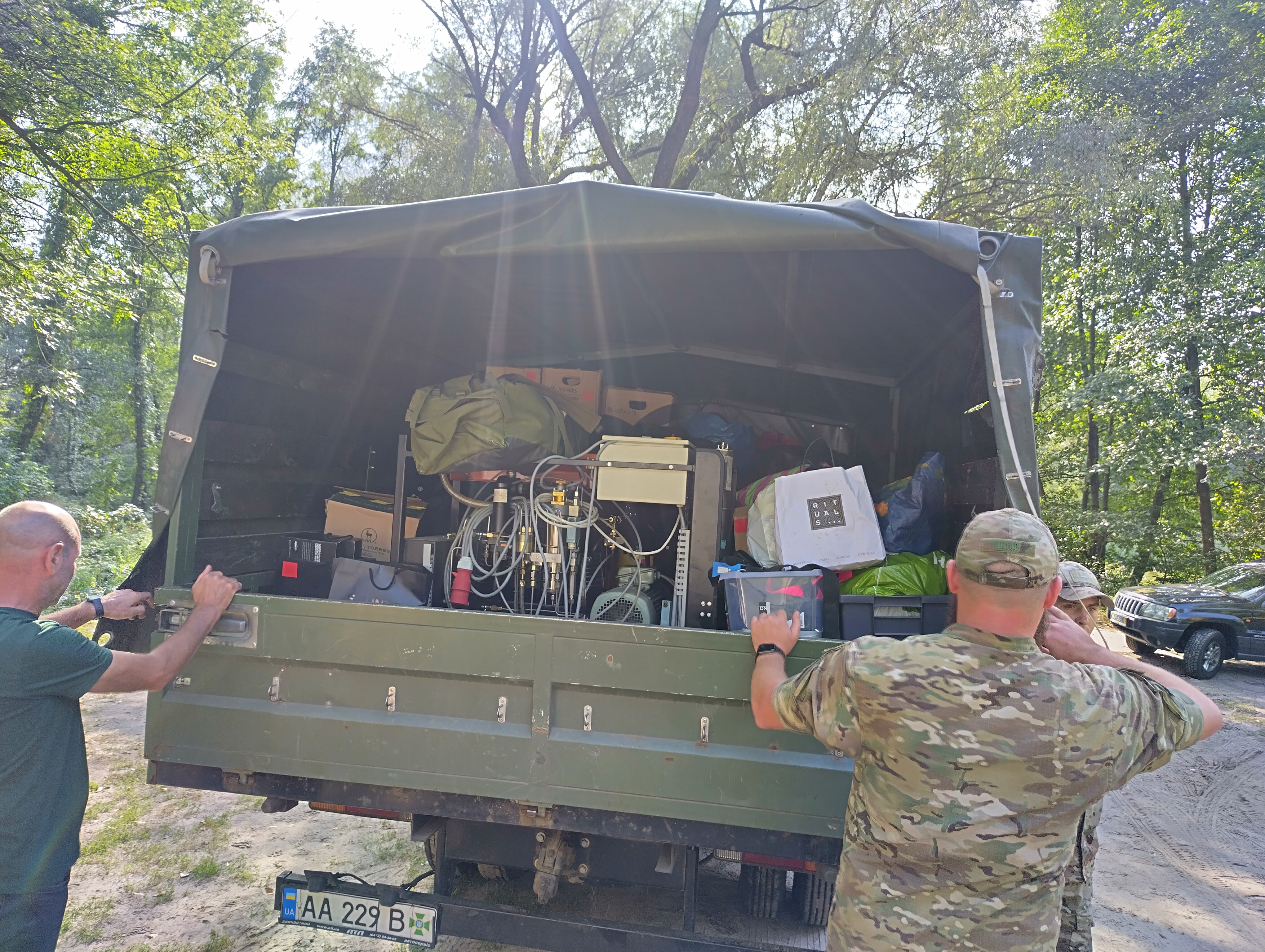Delivering large quantities of mostly old vehicles over long distances is no easy task. Despite our car expert Ville doing his utmost to inspect the vehicles before a potential purchase, as well as fixing issues, replacing parts and oils etc., an old car is still an old car, and many unexpected things can happen along the way. Our latest trip had an unusually high number of problems with the vehicles, which I’ll now tell you a bit about.
On this trip, we had four different vehicles with us – a pick-up truck, two vans, and a cargo truck. In the vehicles, we had loaded fire extinguishing foam, firefighter suits, air canisters for smoke diving, stretchers, computers and monitors, insect repellent, life jackets, and axes. One of the vans was supposed to return to Finland, and the other three vehicles would be donated to Ukraine. I myself drove the pick-up almost the whole way, so we’ll start our story with that.
The pick-up was a Nissan King Cab, older model. It worked pretty well but had some flaws. For example, the radio was dead, and it lacked air conditioning, but most importantly, none of its gauges were functional – so speed, RPM, fuel level, and engine temperature had to be guessed or checked with Google Maps. The only instrument that worked on the dashboard was the clock. This is apparently a common issue with many old Nissans.
So far, so good – we drove down at a good pace through the Baltics and spent the first night in Poland. The next morning, as we continued our journey, my car suddenly lost engine power and slowed down until it came to a stop on the shoulder of a Polish highway. I informed the others that I had a problem, and Leo, who was driving behind me, also stopped. We called Ville and started troubleshooting. Overheated brakes? No. Oil or coolant leakage? All levels looked fine. The car started and idled, but as soon as I gave it a bit of gas, it stalled. We suspected the turbo might have given up, which would have been a major issue.
We called Rikhard, who had stopped at a gas station a bit further ahead, and asked him to buy a tow rope. I waited by the car while he drove back in the opposite lane and made a turn at a ramp a few kilometers back. Fortunately, the spot where I had broken down was on a long gentle uphill stretch with excellent visibility, so the risk of a collision with a passing vehicle was minimal.

Plenty of visibility
When Rikhard reached me, he had also brought a diesel canister. Ville suggested we test if the issue was simply an empty tank, even though it shouldn’t have been according to our estimates of the vehicle’s fuel consumption. We poured the diesel into the tank and manually pumped fuel to the engine (according to Ville’s instructions). And what do you know! The car started right up and ran like a charm. It had just run out of fuel after all – lucky us! We were able to continue our journey after about an hour on the roadside.
Afterwards, we recalculated the fuel consumption based on what we now knew, and it turned out our original “conservative” estimate of about 10 liters/100 km was far from reality. The actual highway consumption was around 14 liters. After that, we refueled much more frequently.
One of the vans was a VW Transporter that had also seen better days. Already in Tallinn, we began noticing a strange rattling sound from the engine when idling. It turned out to be a worn clutch part that made noise as long as a gear wasn’t engaged. According to those in the know, this shouldn’t be a problem. Alright, we continued on, basically problem-free all the way to Kyiv. There we checked into a hotel outside the city limits, and in the morning, when we were about to continue, we found that the van’s rear tire was completely flat. We had a hand pump with us, but some helpful Ukrainians who happened to be in the parking lot lent us their electric compressor. We inflated the tire and heard a distinct hissing sound.
Guys in action
Nothing to do but get the jack out and remove the wheel. The problem was quickly found – a large metal shard had embedded itself in the tire, possibly shrapnel from a bomb that had remained on the road despite Ukrainian efforts to clean such hazards up. 

The fragment that caused us a lot of extra work
We had a patch kit with us which we tried to use. Once that was done, we took the tire to a nearby gas station to have it filled. The station had a small service shop where the guys were changing car tires, and they lent us their compressor. Unfortunately, our patch didn’t hold and was clearly leaking. The service guy offered to repair the tire for us. It would take 20 minutes. We gladly accepted the offer, and twenty minutes later, we had a well-inflated tire. And the cost? About five euros. The guy even asked if we were military, to which we replied no, but that we were helping them. He then gave us a 20% discount.
However, the van’s problems didn’t end there. The same tire started leaking again later, and we sought out a mechanic in that part of the city. He removed the tire and determined that now it was the rim itself that was leaking, likely due to the rough treatment it had endured along the way. Luckily, there was an old spare tire we could use, but the mechanic warned it was in poor condition and wouldn’t last long. Again, he only wanted about 4 euros for nearly an hour of work. We gave him 10 euros, which made him very happy.
So, that must have been all, right? Not at all. Remember that clutch issue from Tallinn? After about 2000 km of hard driving, that defect finally took its toll, and the gearbox broke down during highway driving. Suddenly (after a loud protest), gears 4 and 5 were gone, and only 1-3 could be used. This was the van that was supposed to be driven back to Finland, which now became impossible. The guys had to quickly book flights instead and leave the van to be serviced. It’ll come home at a later stage – if it’s even worth fixing.
Our Volvo truck didn’t make it to its destination unscathed either. After the night outside Kyiv, it too got tired, and a diaphragm in its four-circuit protection valve for the air system gave out when starting it. Without this, the truck had neither brakes nor clutch and thus couldn’t move at all. The right spare part wasn’t easy to find on a Sunday either. With help from our Ukrainian contacts, one was located and promised to us by Monday morning. On Monday, we picked it up along with some tools from a large store and began replacing the part. Easy job, right?
More guys in action
First, it turned out that the tools we had bought were of such poor quality that both the wrench and locking pliers broke before we had even removed the old part. So we had to go out and buy new ones. After acquiring a new, better wrench set, we managed to remove the old part and began installing the new one. Then the new part broke instead. It had molded threads for the hoses, and one of them had a defect that caused it to crack. Frustration! We should have been at the fire station to hand over the fire equipment over an hour ago... Still, there was nothing to do but go get another new part. Forty minutes’ drive to a store, a half-hour wait to get the part from some warehouse, and forty minutes back. Then another installation.
Finally, the part was in place, and with the engine running, the systems got air pressure again. But wait? The compressor is running full blast the whole time. One of the old hoses had cracked during the replacement and was now leaking like a sieve. The truck was driveable, but the compressor was screaming. So we brought up Google Maps again, found a place that repaired trucks, and headed there. Luckily, it very close by, just a few minutes away.
Here as well, the guys were incredibly responsive and helpful. One of them immediately began helping to fix the hose. He ended up replacing the entire hose section for us and even refused to accept payment for the help. In half an hour, our Volvo was finally in good enough condition to drive longer distances.
Unfortunately, by this time, the firefighters had already gone home for the day, so we could no longer personally handle the handover. Our Ukrainian partners took care of it the next day, by which time we had already left the country on a night train. The fire extinguishing foam we brought was received with great gratitude, as Kyiv is currently under constant Russian attacks and rescue supplies are in high demand.
Ukrainian firefighters with our donated fire extinguishing foam
In the end, we can conclude that things don’t always go as planned, but the problems can usually be solved. This was, in any case, a personal record for vehicle problems in my book.


Leave a comment
This site is protected by hCaptcha and the hCaptcha Privacy Policy and Terms of Service apply.